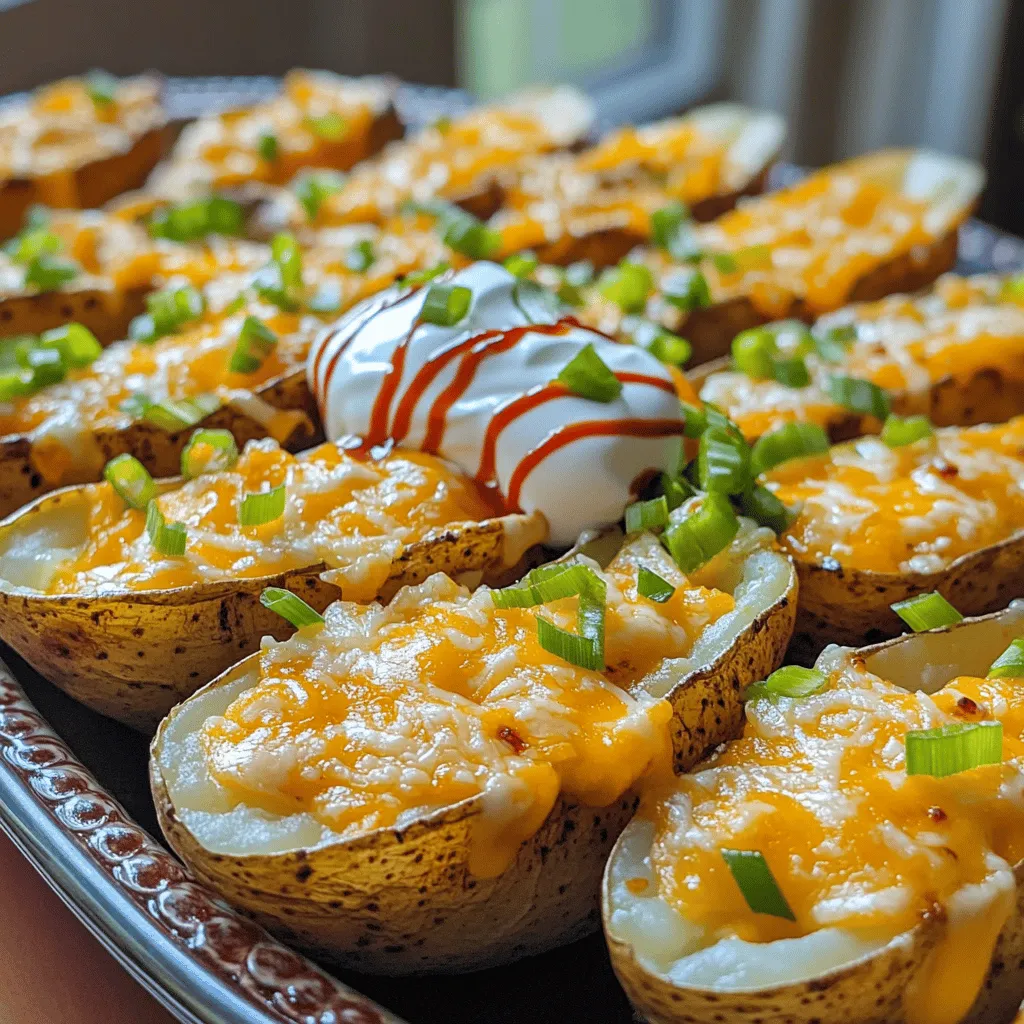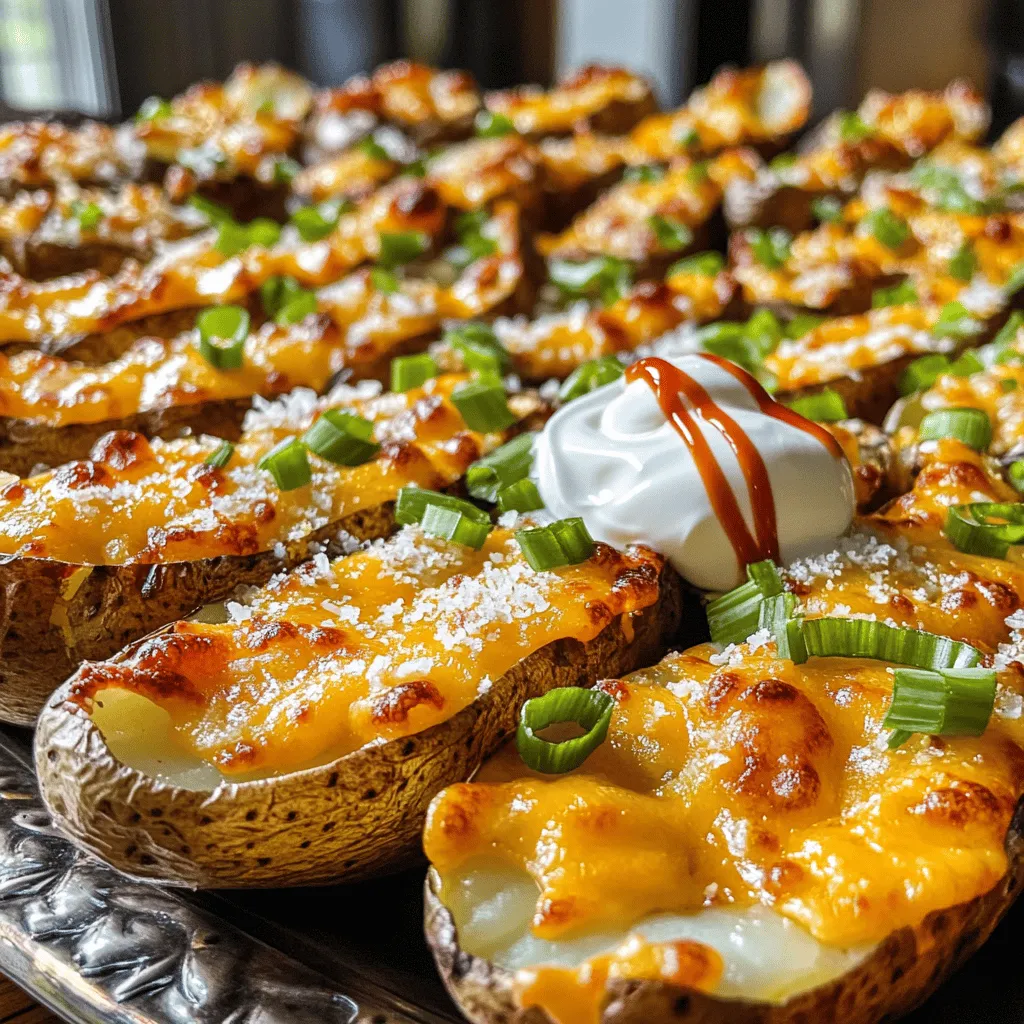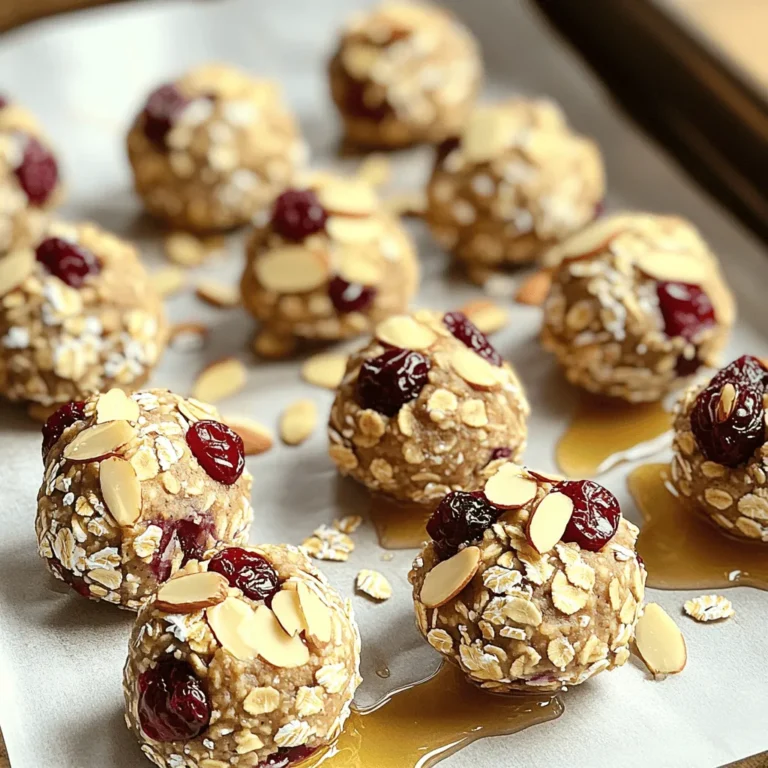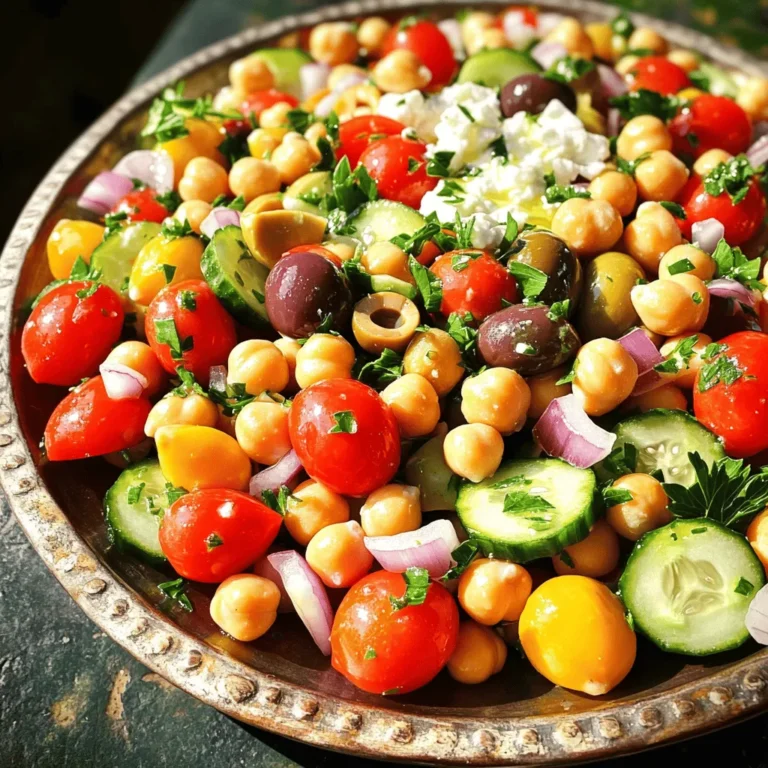Crispy Parmesan Ranch Potato Skins Tasty Snack Recipe

If you’re craving a delicious snack that’s crunchy and packed with flavor, you’ve come to the right place! My Crispy Parmesan Ranch Potato Skins are easy to make and perfect for sharing. With just a few key ingredients and simple steps, you’ll create a mouthwatering treat that will impress anyone. Let’s dive into the ingredients and get cooking! Your taste buds will thank you later!
Ingredients
Essential Ingredients for Crispy Parmesan Ranch Potato Skins
To make Crispy Parmesan Ranch Potato Skins, you need these key items:
- 4 medium russet potatoes
- 1 tablespoon olive oil
- 1 teaspoon garlic powder
- 1 teaspoon onion powder
- 1 teaspoon dried parsley
- ½ teaspoon salt
- ¼ teaspoon black pepper
- ½ cup grated Parmesan cheese
- ½ cup shredded cheddar cheese
- ½ cup sour cream
- 2 green onions, finely sliced
- Optional: hot sauce for drizzling
These ingredients come together to create a tasty snack that everyone will love. The russet potatoes give a great base. Olive oil helps achieve that golden, crispy texture.
Optional Toppings to Enhance Flavor
You can add a few extra toppings for more flavor. Here are some ideas:
- Crispy bacon bits
- Jalapeño slices for heat
- Fresh herbs like chives or cilantro
These toppings can make your potato skins even more exciting. They add different tastes and textures, making your snack feel gourmet.
Key Equipment Needed
You will need some basic kitchen tools to prepare this recipe:
- Baking sheet
- Mixing bowls
- Fork for piercing potatoes
- Spoon for scooping out the insides
Using the right tools helps make the process smooth. Having everything ready means you can focus on creating a delicious dish.
Step-by-Step Instructions
Prepping the Potatoes
Start by washing your russet potatoes well. Make sure to scrub off any dirt. After that, pierce each potato several times with a fork. This helps steam escape while baking. It’s key to avoid burst potatoes. Next, place the potatoes on a baking sheet.
Baking the Potato Skins
Set your oven to preheat at 400°F (200°C). Bake the potatoes for 45 to 60 minutes. They should feel tender when you poke them with a fork. Once done, take them out and let them cool for about 10 minutes. This makes them easier to handle. Then, cut each potato in half lengthwise. Use a spoon to scoop out some of the insides. Leave about a ¼-inch shell. This keeps them sturdy.
Adding Seasoning and Cheese
Brush the inside and outside of each potato skin with olive oil. This helps achieve a nice crisp. In a bowl, mix garlic powder, onion powder, dried parsley, salt, and black pepper. Stir until blended well. Sprinkle this seasoning mix inside each potato skin. Add a generous amount of grated Parmesan cheese and shredded cheddar cheese on top. Place the potato skins back on the baking sheet with cheese-side up. Bake for another 15 to 20 minutes. You want the cheese to be bubbly and golden. The edges should turn crispy. Finally, remove them from the oven and let them cool a bit. Top each skin with sour cream and sliced green onions. If you like heat, drizzle hot sauce for that extra kick.
Tips & Tricks
Achieving Maximum Crispiness
To get the best crispiness from your potato skins, follow these tips:
- Use russet potatoes. Their starch content helps create a crispy texture.
- Bake them until fork-tender. This ensures they are soft inside, which helps when scooping.
- Brush with olive oil. A good layer of oil makes a big difference in crispness.
- Bake again after adding cheese. This final bake allows the cheese to bubble and brown.
How to Select the Best Potatoes
Choosing the right potatoes is key to great potato skins. Here’s what to look for:
- Look for medium-sized russets. They have the right thickness for sturdy skins.
- Check for smooth skin. Avoid potatoes with blemishes or soft spots.
- Choose firm potatoes. This indicates freshness and will help them hold up during baking.
Serving Suggestions for Appetizers
When serving your crispy potato skins, consider these ideas:
- Serve warm. Warm skins are best for tasting the melted cheese.
- Add a variety of dips. Sour cream, ranch, or even guacamole pairs well.
- Garnish with fresh herbs. Chopped parsley or cilantro adds color and flavor.
- Create a platter. Arrange them on a large dish for a fun sharing experience.

Variations
Different Cheese Options to Consider
You can switch up the cheese in your potato skins. While Parmesan and cheddar work great, try mozzarella for a gooey texture. Goat cheese adds a tangy twist. For a sharper taste, use aged cheddar. Mixing cheeses can create a richer flavor.
Vegetarian-Friendly Alternatives
If you want a vegetarian option, skip the cheese or use plant-based cheese. You can load the skins with veggies. Try adding spinach, mushrooms, or bell peppers. They add color and taste without meat. This makes your snack healthy and fun.
Spicy Variants of Potato Skins
For spice lovers, add some heat! Mix jalapeños or chili flakes in your cheese topping. You can also drizzle hot sauce over the sour cream. This adds a tasty kick. For an even spicier option, consider using pepper jack cheese. It packs a punch and enhances the flavor of your crispy potato skins.
Storage Info
How to Store Leftover Potato Skins
To keep your crispy potato skins fresh, let them cool completely. Place them in an airtight container. You can store them in the fridge for up to three days. Make sure to separate layers with parchment paper to avoid sticking.
Reheating Tips for Best Results
When you’re ready to enjoy the leftovers, reheat them in the oven. Set your oven to 350°F (175°C). Place the potato skins on a baking sheet and heat for about 10-15 minutes. This method keeps them crispy. Avoid using a microwave, as it can make them soggy.
Freezing Instructions
You can freeze these potato skins if you want to save them for later. First, let them cool completely. Wrap each skin tightly in plastic wrap, then place them in a freezer bag. They will stay good for up to two months. When you’re ready to eat them, thaw in the fridge overnight before reheating.
FAQs
What type of potatoes are best for this recipe?
I recommend using medium russet potatoes. They have a thick skin and a fluffy inside. This makes them perfect for holding toppings. Their texture gives you that nice crispiness after baking.
Can I make these potato skins in advance?
Yes, you can prepare the potato skins ahead of time. Bake the potatoes and scoop out the insides. Store the skins in the fridge. When you’re ready, add your toppings and bake them. This saves time when you need a quick snack.
How long do Crispy Parmesan Ranch Potato Skins stay fresh?
These potato skins are best enjoyed fresh. However, they can last in the fridge for up to three days. Just store them in an airtight container. Reheat them in the oven for the best results.
Is it possible to make these potato skins in an air fryer?
Absolutely! You can use an air fryer for a quicker option. After preparing the potato skins, air fry them at 375°F for about 10-15 minutes. This gives you that crispy texture you love without using the oven.
Crispy Parmesan Ranch Potato Skins are a winning snack choice. We covered essential ingredients, step-by-step baking, and tips for maximum crispiness. Don’t forget to explore tasty variations and proper storage methods.
These skins are easy to make and will impress your friends. Enjoy your delicious creations!



![To make a tasty avocado corn salad, gather these ingredients: - 2 ripe avocados, diced into bite-sized cubes - 1 cup sweet corn (freshly grilled or canned, drained) - 1 cup cherry tomatoes, halved for a juicy burst - 1 red bell pepper, diced finely for crunch - 1/4 cup red onion, finely chopped for sharpness - 1/4 cup fresh cilantro, chopped for herbal freshness - Juice of 2 limes for tanginess - 2 tablespoons extra virgin olive oil for richness - 1 teaspoon ground cumin for warmth - Salt and freshly cracked pepper to taste Using good-quality ingredients makes a big difference. Choose ripe avocados that yield slightly when pressed. This means they are soft and ready to eat. Fresh corn adds a sweet touch. If you use canned corn, drain it well to keep the salad fresh. Opt for vibrant cherry tomatoes and a crunchy red bell pepper, both of which enhance the salad's look and taste. Fresh cilantro can elevate the flavor, so use it if you like its taste. If you have allergies or preferences, you can easily swap some ingredients. Try using lime juice from one lemon instead. For those with onion allergies, you can skip the red onion or use green onions. If you are not a fan of cilantro, parsley works well too. For a creamier texture, consider adding a bit of Greek yogurt. This makes the salad rich while keeping it fresh. For the complete recipe, check out the [Full Recipe]. To make the avocado corn salad, start by gathering all your ingredients. You need ripe avocados, sweet corn, cherry tomatoes, red bell pepper, red onion, cilantro, lime juice, olive oil, cumin, salt, and pepper. First, take a large bowl. Add the diced avocados and the corn. If you use canned corn, drain it well. Mix these two gently to spread the sweetness of the corn. Next, add the halved cherry tomatoes, diced red bell pepper, and finely chopped red onion. These ingredients give your salad a bright look and a tasty crunch. After that, sprinkle the chopped cilantro over everything. This adds a fresh flavor that brightens the dish. Now, grab a small bowl. Whisk the lime juice, olive oil, cumin, and a pinch of salt and pepper together. This dressing will tie all the flavors in the salad. Pour the dressing over the salad mixture. Use a spatula or wooden spoon to mix everything gently. Be careful not to mash the avocados. Finally, taste your salad. You might want to add more salt or lime juice based on your taste. When mixing, go slow. You want to keep the avocados intact. Over-mixing can turn them mushy. Use a light hand and fold the ingredients together. This keeps your salad looking fresh and colorful. If you notice some pieces are not coated well, you can add a bit more dressing. Just drizzle it slowly and mix again. This helps every bite to burst with flavor. For the best taste, let your salad sit for about 10 minutes at room temperature. This allows the flavors to blend. If you serve it right away, the tastes might not be as strong. After resting, your salad will be ready to eat. Enjoy it fresh for lunch or as a side with dinner. For the full recipe, click here. To select ripe avocados, look for a dark green color. Gently squeeze the avocado; it should feel firm but yield slightly. Avoid any that feel mushy. A ripe avocado should have a smooth skin without dark spots. If you find unripe avocados, leave them at room temperature for a few days. Once ripe, use them within a day or two for best taste. Grilling fresh corn adds a smoky flavor that enhances your salad. Start by husking the corn and removing all silk. Brush the kernels with oil to prevent sticking. Place the corn directly on a hot grill for about 10 minutes. Turn it every few minutes until it’s tender and has grill marks. This method caramelizes the sugars, making the corn sweeter and more delicious. To enhance your salad's flavor, adjust the seasonings to your taste. Start with lime juice and olive oil, then add cumin for warmth. If you prefer a kick, include a pinch of chili powder or chopped jalapeños. Fresh herbs can also brighten the dish. Always taste and adjust as you go. Remember, a little salt can go a long way in bringing out flavors. For more detailed instructions, check the Full Recipe. {{image_4}} You can boost the protein in your avocado corn salad easily. Adding chicken or shrimp makes it more filling. Grilled chicken breast works well; just chop it into bite-sized pieces. For shrimp, try sautéing or grilling them until they are pink. Both options blend nicely with the salad's flavors. You can also use canned chickpeas for a plant-based choice. Just rinse and add them directly for a hearty twist. The dressing can change the whole taste of your salad. A simple lime vinaigrette adds a refreshing zing. Just whisk lime juice, olive oil, salt, and pepper together. For a creamy dressing, mix yogurt with lime juice and cumin. This gives a nice tang and creaminess. You could also try a cilantro-lime dressing for extra flavor. Feel free to experiment with different dressings to find your favorite. Using seasonal ingredients makes your salad even better. In summer, fresh peaches or strawberries add a sweet touch. In fall, diced apples or pears give crunch and sweetness. You can also swap the corn for roasted butternut squash in winter. This keeps your salad fresh and exciting all year. Think about what’s in season for tasty swaps that match the flavors of your dish. For the complete recipe, check out the [Full Recipe]. To store leftover avocado corn salad, use an airtight container. This keeps the air out and helps avoid spoilage. Place the salad in the fridge right after serving. It tastes better cold and stays fresh longer. If you have extra dressing, store it separately to keep the salad crisp. The salad will last about 2 days in the fridge. The avocados may brown, but the taste remains good. Corn and tomatoes hold well for a bit longer. If you used canned corn, it can stay fresh for 3 to 4 days. Always check for any off smells before eating leftovers. To keep avocados fresh, store them whole until you're ready to use them. If you've cut an avocado, squeeze some lime juice on it. The acid helps slow browning. Cover it tightly with plastic wrap or place it in an airtight container. This way, you can enjoy your avocado longer without losing its bright color. To stop avocados from browning, use lime juice. The acid slows down oxidation. You can also store cut avocados with the pit in. Cover them tightly with plastic wrap. This keeps air out and helps maintain their color. Yes, you can prepare the salad in advance. However, add the avocados right before serving. This keeps them fresh and green. If you store it for later, put plastic wrap directly on the surface. This minimizes air exposure and keeps the salad tasty. Look for fresh corn with bright green husks. The kernels should feel plump and firm. If using canned corn, choose a brand with low sodium. Drain and rinse it well to remove extra salt. This will help the corn taste fresh and sweet in your salad. Enjoy the crunch and sweetness! For the complete recipe, check out the Avocado Corn Salad Delight. In this blog post, we covered how to make a delicious avocado corn salad. We explored the best ingredients, tips for preparation, and ways to enhance flavor. You can mix and match based on your taste and needs. Remember to store leftovers properly to keep them fresh. With easy swaps and answers to common questions, you’ll create a great dish every time. Now, you have everything you need to impress your family and friends with your new salad skills. Enjoy making your own special version!](https://dishtreats.com/wp-content/uploads/2025/07/333f1f81-7d50-4cc6-bd3d-a33e08904fb9-768x768.webp)
![To make delicious grilled veggie kabobs, gather these fresh ingredients: - 1 bell pepper (any color), cut into 1-inch pieces - 1 zucchini, sliced into rounds - 1 yellow squash, sliced into rounds - 1 red onion, cut into wedges - 8 cherry tomatoes - 1 cup mushrooms, cleaned and stems removed - 3 tablespoons olive oil - 2 cloves garlic, finely minced - 1 teaspoon smoked paprika - 1 teaspoon dried oregano - Salt and freshly ground black pepper to taste - 8 skewers (wooden or metal) Fresh vegetables make a big difference in flavor. You can swap in seasonal veggies, like asparagus or eggplant, based on what you find at the market. This keeps your kabobs fresh and exciting. If you have frozen vegetables, use those too! Just remember to thaw and drain them well. Fresh veggies often taste better but frozen can be a great backup. Using fresh ingredients ensures better taste and texture. Fresh veggies hold their shape and crunch better on the grill. When you bite into a grilled kabob, you want that satisfying crunch. Plus, fresh produce packs more nutrients and flavor. So, always try to choose fresh when you can! For the full recipe, check the section above. Cutting vegetables evenly ensures they cook at the same rate. Aim for 1-inch pieces for bell peppers and wedges for onions. Slice zucchini and yellow squash into rounds. If using wooden skewers, soak them in water for at least 30 minutes. This step prevents burning and keeps them strong. Marinating vegetables adds rich flavor. Combine olive oil, minced garlic, smoked paprika, and oregano. Toss in salt and pepper, then mix well. Add your veggies and coat them with the marinade. Let them sit for 15 minutes to soak up the flavors. Preheat your grill to medium-high heat. A hot grill helps create nice grill marks and a good sear. Place the kabobs on the grill grates. Arrange them evenly for better cooking. Cook for about 10-15 minutes. Turn them occasionally to ensure even cooking. Look for tender veggies with nice grill marks. To serve kabobs, use a rustic platter for a warm touch. Garnish with fresh herbs for added color. Serve with tzatziki or yogurt dip for a creamy contrast. Pair with a light salad or grilled protein for a complete meal. Enjoy your delicious creation! For the full recipe, check out the Grilled Veggie Kabobs details above. To boost the taste of your grilled veggie kabobs, try different marinades. Balsamic vinegar adds a sweet tang. Citrus juices like lemon or lime give a bright kick. You can also add spices or herbs. Consider rosemary, thyme, or cayenne pepper for extra flavor. Smoking the veggies adds depth too. If you have a grill with a smoker box, use it. Wood chips like hickory or mesquite can make a big difference. When you assemble your kabobs, think about color and texture. Alternate your veggies for a pretty look. Start with a bell pepper, then add a mushroom, followed by a cherry tomato. This keeps the kabob interesting. To prevent veggies from falling apart, push them snugly together on the skewer. Avoid overloading them; a little space helps. You can also add proteins like chicken or shrimp, or even cheese cubes for variety. This makes your kabobs more filling and tasty. For a twist, try marinating the protein in the same mix as the veggies. If you want to dive deeper into the recipe, check out the Full Recipe for more details! {{image_4}} You can easily customize grilled veggie kabobs by using seasonal vegetables. Here are some ideas: - Summer: Try corn on the cob, eggplant, and asparagus. - Fall: Use butternut squash, Brussels sprouts, and sweet potatoes. - Winter: Consider root veggies like carrots, turnips, and beets. You can also grill fruits alongside your veggies. Fruits add sweetness and a nice contrast. Pineapple, peaches, and bell peppers work well. Skewer them together for fun color and taste. For a great look and texture, combine different colors and shapes. Mix round cherry tomatoes with long zucchini slices. Use bright peppers with earthy mushrooms. This creates visual interest on your plate. You can make grilled veggie kabobs vegan by omitting any animal products. The recipe is already plant-based, so it’s a perfect choice. If you want a gluten-free version, ensure your marinade is gluten-free. Most spices and oils are safe, but check labels. You can enhance nutrition by adding grains or legumes. Try adding cooked quinoa or chickpeas to your kabobs. This gives extra protein and fiber. If you follow a low-carb diet, focus on non-starchy vegetables. Zucchini, bell peppers, and mushrooms are great picks. You can skip the starchy veggies like corn or potatoes. Check out the Full Recipe for more ideas on how to adapt these kabobs! To keep your leftover kabobs fresh, store them in the fridge. Place them in an airtight container. They can last up to three days. For longer storage, freeze them. Wrap each kabob in plastic wrap, then place them in a freezer bag. They can stay frozen for up to three months. When reheating kabobs, use the oven or grill. Preheat the oven to 350°F. Place the kabobs on a baking sheet. Heat them for about 10 minutes. This method keeps the veggies tender. You can also grill them for 5 minutes on medium heat. Avoid microwaving, as it makes them soggy. The freshness of your ingredients matters. Bell peppers and zucchini last well in the fridge for about a week. Tomatoes and mushrooms are best if used within three days. Always check for signs of spoilage before using leftovers. You can prep veggies ahead of time for easy grilling. Cut your bell pepper, zucchini, and onion in advance. Store them in the fridge in sealed bags. This saves time when you're ready to grill. Kabobs are great for meal plans. You can mix and match different veggies throughout the week. Pair them with grains or salads for a full meal. They also work well for lunch boxes. Just make sure to keep them cool until you eat. If you have a gathering, kabobs are a hit! You can set up a kabob station. Guests can choose their favorite veggies. This adds fun and personalization to your meal. Kabobs not only taste great but also look colorful and inviting on the table. For the complete recipe, check out the [Full Recipe]. Can I make these kabobs in the oven? Yes, you can! Set your oven to 400°F. Place the kabobs on a baking sheet. Bake for about 20 minutes, turning halfway through. This gives you a tasty option when grilling isn't possible. What are the best vegetables for grilling? The best vegetables for grilling include: - Bell peppers - Zucchini - Yellow squash - Red onion - Cherry tomatoes - Mushrooms These veggies hold up well on the grill and taste great! How to know when the vegetables are done cooking? Look for nice grill marks and tenderness. You can pierce them with a fork. If they are soft but still firm, they are ready to eat. How to make grilled veggie kabobs more flavorful? Use a good marinade with olive oil, garlic, and spices. Let the veggies soak in the marinade for at least 15 minutes. This step really boosts their taste. Why should you marinate vegetables? Marinating adds flavor and helps keep them juicy. The oil and spices soak into the veggies, making each bite delicious. What type of skewers work best for grilling? Both wooden and metal skewers work well. If using wooden skewers, soak them first. This prevents burning. Metal skewers can be reused and do not need soaking. Can I use tofu or tempeh in veggie kabobs? Yes, tofu or tempeh can add protein. Cut them into cubes and marinate like the veggies. They grill nicely and taste great with the other flavors. How do I prevent vegetables from burning on the grill? Start with a clean grill and preheat it. Keep an eye on the kabobs while grilling. Turn them often to ensure even cooking and avoid burning. What can I serve alongside grilled veggie kabobs? Serve kabobs with dips like tzatziki or hummus. They also pair well with rice, quinoa, or a fresh salad. Adding some bread can complete the meal nicely. You now have all the tools to create delicious grilled veggie kabobs. We covered essential ingredients, preparation methods, grilling tips, and serving ideas. Remember, fresh ingredients make a big difference. You can also customize with various vegetables and flavors. Don’t forget to store leftovers properly for future meals. Enjoy your grilling adventure, and get creative with your kabob variations. With practice, you'll master this fun cooking method that delights everyone!](https://dishtreats.com/wp-content/uploads/2025/06/56cc5cbd-3bee-4e7d-a92f-dff27107e6fe-768x768.webp)

. - Ensure even space on the baking sheet for optimal roasting. - Toss halfway through cooking for uniform caramelization. Roasting carrots and chickpeas makes them sweet and crunchy. When you spread them out, they cook evenly. If they touch, they steam instead of roast. This can make them soggy and less tasty. Tossing the mixture halfway is key. It helps to brown all sides well. This step adds more flavor and a lovely texture. - Experiment with different citrus juices like lime or orange. - Substitute tahini with Greek yogurt for a creamy dressing. The dressing can change the whole dish. Use lime juice for a zesty twist. Orange juice gives a sweet touch. Both add freshness and brightness. If you want a creamy option, use Greek yogurt instead of tahini. It makes the dressing rich and smooth. This swap gives a fun flavor change too. - Serve in individual bowls for a refined presentation. - Add a lemon wedge for guests to use. Presenting this salad in bowls looks nice. It makes each serving feel special. Guests can enjoy their own portion. Adding a lemon wedge on the side is a great idea. It lets everyone add a splash of fresh juice. This brightens the salad even more. For the full recipe, check the details above. Enjoy your cooking! {{image_4}} You can make this salad even better. Try adding other roasted veggies. Bell peppers bring sweetness. Sweet potatoes add creaminess. Both enhance flavor and texture. You can also toss in nuts or seeds. Almonds or sunflower seeds add a nice crunch. They make the salad more filling and fun. If you want more protein, try grilled chicken or tofu. Both options work well with roasted carrots and chickpeas. Grilled chicken adds a savory touch, while tofu keeps it plant-based. You can also use canned tuna. It gives the salad a different flavor and makes it heartier. Want to boost flavor? Experiment with fresh herbs. Cilantro or mint can brighten the taste. They add freshness that complements the roasted veggies. You can also spice it up with hot sauce. Just a dash gives the salad a nice kick. It’s a fun way to change the flavor profile. For the complete recipe, check out the Full Recipe section above. Store leftovers in an airtight container in the fridge. They are best consumed within 2-3 days. After that, the carrots may lose their crunch, and the flavors fade. Freezing this salad is not recommended. The dressing may separate when frozen. This can change the texture and taste of your salad. You can enjoy this salad cold or at room temperature. If you prefer, reheat in the oven. This helps retain the texture of the roasted carrots and chickpeas. Yes, use maple syrup instead of honey and omit the feta cheese. This keeps the flavors rich and plant-based. You won’t miss the cheese, trust me. The roasted carrots and chickpeas bring enough taste and texture to satisfy everyone. You can use black beans or white beans as alternatives. Both options provide protein and fiber. They also add a nice twist to the taste. Black beans bring a bit of earthiness, while white beans offer a creamier texture. Serve the dressing on the side to keep the greens crisp until serving. This way, they stay fresh and crunchy. Drizzle the dressing just before you eat for the best taste and texture. Spinach, arugula, or chopped kale work well for base greens. Each option adds a different flavor. Spinach is mild, arugula is peppery, and kale adds a hearty bite. Choose what you like best! This blog post shares a tasty recipe featuring roasted carrots and chickpeas on fresh greens. It walks through each step, from prep to assembly, and includes tips for perfect results. You can even tweak the dressing and add your favorite proteins. Don’t hesitate to make this salad your own. Experimenting with flavors makes cooking fun! Enjoy your healthy, vibrant salad that brings flavor and nutrition to your table.](https://dishtreats.com/wp-content/uploads/2025/07/15b40619-46f3-4baf-96e6-94c974b2a42a-768x768.webp)
